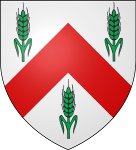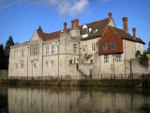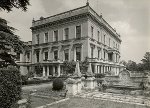

Local judges (3) - Whitechapel County Court
| The
paper of Prof. Hindley was a review of an essay on 'The English
Possessive Augment', by Serjeant James Manning of Oxford, Eng.,
published in the Transactions of the Philological Society (London
1864). Mr Manning holds that the Anglo-Saxon genitive was given up in
the 13th century, and its place supplied by of with the accusative; but that for the possessive relation, a special form was then introduced, such as 'father his book', 'mother his gown', 'children his
plaything', which gradually passed into 'father's book', 'mother's
gown', 'children's plaything'. Against the common view, which
identifies the s of our
possessive with that of the A.-S. genitive, he urges that the latter
was not applied to feminines and plurals, and that it was used for many
relations which are not expressed by our possessive. But Prof. Hadley
referred to examples of grammatical forms (as the s
of plural nouns in French and Spanish) extended to classes of words
that once excluded them, and of forms (as the Latin perfect indicative
active in all Romance languages) restricted in the range of meanings
that once belonged to them. He examined the constructions of our
possessive which Mr. Manning regards as inconsistent with its genitive
origin. In 'Cæsar's crossing the Rubicon' we have only the ordinary use
of a genitive to denote the subject of an action. In 'John and Walter's
house' the possessive s is added to 'John and Walter' taken as a complex whole; compare eth in 'three-and-twentieth'. The same explanation applies to 'King of England's crown': compare ism
in 'Church-of-England-ism'. In 'a servant of my brother's', Lowth
regarded 'brother's' as depending on 'servants' understood—an
explanation which fails for 'that wife of my brother's': it is better
to regard the genitive here as dependent on a general idea of
'belongings', 'that which belongs', the same idea which is evidently
understood in 'all mine is my brother's'. Positive arguments for his
own view Mr. Manning draws from the popular dialects of modern Germany,
and from the usage of Semi-Saxon and early English writers. But while
the common German says 'des Vaters sein Buch', he says 'der Mutter ihr Kleid': if our English possessive were of the same nature, we should have, not 'mother his gown' (according to Mr. M.'s theory) but 'mother her gown'. That the Gothic reflexive seins and the Latin reflexive suus mean her and their as well as his, proves, at most only a possibility that his]might be so used in place of her:
that it was actually and currently used in this way, there is no
sufficient reason for believing. In almost every instance where it
seems to be used, his refers to a word like wife, maiden, child, which in Anglo Saxon were neuter not feminine. Mr
Manning gives great prominence to a comparison between the two
manuscripts of Layamon's Brut. in the first of which, written about
1200 A.D., the genitive expressed by his is rarely, if ever, met
with; while in the second, written perhaps sixty years later, such
forms are of common occurrence. Even here, in examining amining the
first 9000 lines of the poem, Prof. Hadley had found, from common
nouns, about eighty genitives with inflectional s, and only two
expressed by his; from proper names of place, thirteen with
inflectional s, and two expressed by his; even from proper names of
persons, where the genitives expressed by his are numerous there are
nearly as many with inflectional s, and the two forms are and freely
and capriciously interchanged. In the Ormulum, written bv a very
careful scribe at a time not earlier than the second text of Layamon,
the form with his is never once used. And although this form is often
seen in old English writings, and to the beginning of the last century,
yet it appears, on the whole, as an occasional—and, seemingly, a merely
orthographic—variation of the inflectional genitive—a variation
suggested by a false, though plausible, etymology, and favored [sic] by
general confusion of early English orthography. In connection with this paper, Prof. Whitney referred to another and wholly account of our possessive suffix, given in the Reader for Sept. 24, 1864, in the form of a critique upon Mr. Manning's essay, under the signature of Th. G. [Prof. Goldstücker}. Its author accepts as satisfactory Mr. Manning's disproof of the relationship between the suffix in question and the ancient genitive-ending, but regards the former as a mere connecting-link between the name of the possessor and the thing possessed, binding them together into a kind of compound. Prof. Whitney combated this view, as in a high degree far-fetched and fanciful, and attempted to overthrow the arguments by which it was supported. There is no more difficulty, he claimed, in supposing the retention of a true synthetic form along with the elaboration of an analytic substitute for it in the case of John's son and the son of John, than in the case of I loved and I did love. The position of the possessive before the thing possessed is no more fixed in the case of a noun than in that of a pronoun, as his or her, which no one would think of denying to be ancient genitives. And the s in such German words as Hilfstruppen, Liebesgabe is really a genitive-ending, or introduced after the analogy of such; precisely as is the s of nachts, formed after the analogy of abends, morgens, etc. |
 Sir Walter Buchanan Riddell - (1863-??)
Sir Walter Buchanan Riddell - (1863-??) 
 The family home
by then was at (all or part of?) The Palace, Maidstone - originally, in
the 14th century, a palace of the Archbishop of Canterbury (and nowadays a popular wedding venue). A younger
brother, Canon John Charles Buchanan Riddell, was Rector of nearby
Harrietsham. Sir Walter was appointed Recorder of Maidstone &
Tenterden in 1846 (in the room of [= succeeding] R G Temple, deceased)
and continued to hold this office alongside others until 1868, when the
Mayor of Maidstone moved a vote of thanks for his contribution to
the town.
The family home
by then was at (all or part of?) The Palace, Maidstone - originally, in
the 14th century, a palace of the Archbishop of Canterbury (and nowadays a popular wedding venue). A younger
brother, Canon John Charles Buchanan Riddell, was Rector of nearby
Harrietsham. Sir Walter was appointed Recorder of Maidstone &
Tenterden in 1846 (in the room of [= succeeding] R G Temple, deceased)
and continued to hold this office alongside others until 1868, when the
Mayor of Maidstone moved a vote of thanks for his contribution to
the town. | On Tuesday night last, Dec. 26, 1843, Sir Walter Riddell, Bart., was returning to his residence at the Palace, Maidstone, when, on passing
the mill-head of Messrs. Mercer and Parton's mills, the honourable
baronet met a man and woman, and immediately afterwards heard a splash
in the water and a cry of distress. Sir Walter hastened to the spot,
and seeing something on the surface of the water, which is at this spot
about six feet deep, and runs with a rapid current under a low archway
of the mill, without hesitation plunged in with all his clothes on, and
succeeded in saving from a watery grave the woman whom he had passed
just before, and who, by some means or other not clearly ascertained,
had got into this most dangerous situation, from which, without the
honourable baronet's aid, there is no probability that she could have
been rescued. The difficulty of effecting a landing from a deep piece
of water on a perpendicular bricked
embankment is obvious; and had not the man assisted in getting her on
the bank, it is not likely that Sir Walter could have accomplished his
humane object, if indeed he had himself escaped a watery grave. (Signed) Edw. Pickard Hall, Maidstone. N.B. The Secretary of the Institution is indebted to Sir John Croft, who resides at Millgate, near Maidstone, for the following additional particulars: — Sir Walter Riddell, on rescuing the woman, carried her towards a public-house, upwards of two hundred yards. His strength failing him, he obtained assistance, and had her conveyed to the Man of Kent, where he remained in his wet clothes, affording every means for her recovery, for an hour and a half. The night was intensely dark, and nothing but the most prompt and determined energy on his part could have saved him from being swept by the rapid mill-race through the low arch with the woman whose life he saved. |
| On Monday
evening a crowded public meeting of freeholders and other electors of
West Kent was held at the Lecture Hall, Woolwich, for the purpose of
hearing an address from C. W. Martin, Esq, explanatory of his political
principles as a candidate for their suffrages. The chair was occupied
by F. Bennoch, Esq., and Mr. Martin, at some length, avowed himself an
advocate of an extension of the suffrage, a repeal of the income-tax, a
total and unconditional repeal of Church-rates, and of reforms in the
army, navy, and civil service. In reply to questions, Mr. Martin said
he was opposed to the ballot, and in favour of a continuance of the
Maynooth grant. Several electors expressed themselves strongly in
favour of the ballot, and ultimately a resolution was unanimously
adopted, pledging the meeting to support Mr. Martin at the ensuing
election. A similar meeting has been held at Greenwich, at which Mr. Whitehurst and other members of the Ballot Society were present, but not being electors could not be heard. A numerous meeting of the supporters of Sir W. B. Riddell, the Conservative candidate, was held at Maidstone, on Thursday afternoon, at which Viscount Holmerdale presided. |
 Judge Riddell
died in 1892 at Henham Hall, Suffolk [right] - another stately pile (at one
time among the 'top five' landed estates): the redbrick Tudor house was
rebuilt in the 1790s after a major fire, and given a Victorian
'makeover' by Edward Middleton Barry (third son of Sir Charles Barry); it was demolished in 1950. See further
Alan Mackley 'The Construction of Henham Hall' in vol 6 of the Journal of the
Georgian Group (1996).
Judge Riddell
died in 1892 at Henham Hall, Suffolk [right] - another stately pile (at one
time among the 'top five' landed estates): the redbrick Tudor house was
rebuilt in the 1790s after a major fire, and given a Victorian
'makeover' by Edward Middleton Barry (third son of Sir Charles Barry); it was demolished in 1950. See further
Alan Mackley 'The Construction of Henham Hall' in vol 6 of the Journal of the
Georgian Group (1996).
Back
to Policing and Courts